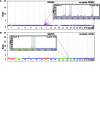Characterization of novel and complex genomic aberrations in glioblastoma using a 32K BAC array
- PMID: 19304958
- PMCID: PMC2802400
- DOI: 10.1215/15228517-2009-013
Characterization of novel and complex genomic aberrations in glioblastoma using a 32K BAC array
Abstract
Glioblastomas (GBs) are malignant CNS tumors often associated with devastating symptoms. Patients with GB have a very poor prognosis, and despite treatment, most of them die within 12 months from diagnosis. Several pathways, such as the RAS, tumor protein 53 (TP53), and phosphoinositide kinase 3 (PIK3) pathways, as well as the cell cycle control pathway, have been identified to be disrupted in this tumor. However, emerging data suggest that these aberrations represent only a fraction of the genetic changes involved in gliomagenesis. In this study, we have applied a 32K clone-based genomic array, covering 99% of the current assembly of the human genome, to the detailed genetic profiling of a set of 78 GBs. Complex patterns of aberrations, including high and narrow copy number amplicons, as well as a number of homozygously deleted loci, were identified. Amplicons that varied both in number (three on average) and in size (1.4 Mb on average) were frequently detected (81% of the samples). The loci encompassed not only previously reported oncogenes (EGFR, PDGFRA, MDM2, and CDK4) but also numerous novel oncogenes as GRB10, MKLN1, PPARGC1A, HGF, NAV3, CNTN1, SYT1, and ADAMTSL3. BNC2, PTPLAD2, and PTPRE, on the other hand, represent novel candidate tumor suppressor genes encompassed within homozygously deleted loci. Many of these genes are already linked to several forms of cancer; others represent new candidate genes that may serve as prognostic markers or even as therapeutic targets in the future. The large individual variation observed between the samples demonstrates the underlying complexity of the disease and strengthens the demand for an individualized therapy based on the genetic profile of the patient.
Figures


Similar articles
-
Identification of novel candidate target genes in amplicons of Glioblastoma multiforme tumors detected by expression and CGH microarray profiling.Mol Cancer. 2006 Sep 26;5:39. doi: 10.1186/1476-4598-5-39. Mol Cancer. 2006. PMID: 17002787 Free PMC article.
-
Novel amplifications in pediatric medulloblastoma identified by genome-wide copy number profiling.J Neurooncol. 2012 Mar;107(1):37-49. doi: 10.1007/s11060-011-0716-0. Epub 2011 Oct 7. J Neurooncol. 2012. PMID: 21979893
-
Microarray-based comparative genomic hybridization (array-CGH) as a useful tool for identifying genes involved in Glioblastoma (GB).Methods Mol Biol. 2010;653:35-45. doi: 10.1007/978-1-60761-759-4_3. Methods Mol Biol. 2010. PMID: 20721736 Review.
-
Detrended fluctuation analysis of genome-wide copy number profiles of glioblastomas using array-based comparative genomic hybridization.Neuro Oncol. 2004 Oct;6(4):281-9. doi: 10.1215/S1152851703000632). Neuro Oncol. 2004. PMID: 15494095 Free PMC article.
-
Emerging insights into the molecular and cellular basis of glioblastoma.Genes Dev. 2012 Apr 15;26(8):756-84. doi: 10.1101/gad.187922.112. Genes Dev. 2012. PMID: 22508724 Free PMC article. Review.
Cited by
-
Contactin 1: An Important and Emerging Oncogenic Protein Promoting Cancer Progression and Metastasis.Genes (Basel). 2020 Jul 31;11(8):874. doi: 10.3390/genes11080874. Genes (Basel). 2020. PMID: 32752094 Free PMC article. Review.
-
Detailed characterization of alterations of chromosomes 7, 9, and 10 in glioblastomas as assessed by single-nucleotide polymorphism arrays.J Mol Diagn. 2011 Nov;13(6):634-47. doi: 10.1016/j.jmoldx.2011.06.003. Epub 2011 Aug 30. J Mol Diagn. 2011. PMID: 21884817 Free PMC article.
-
Glioma-amplified sequence KUB3 influences double-strand break repair after ionizing radiation.Int J Oncol. 2013 Jul;43(1):50-6. doi: 10.3892/ijo.2013.1937. Epub 2013 May 13. Int J Oncol. 2013. PMID: 23670597 Free PMC article.
-
BNC2 is a putative tumor suppressor gene in high-grade serous ovarian carcinoma and impacts cell survival after oxidative stress.Cell Death Dis. 2016 Sep 22;7(9):e2374. doi: 10.1038/cddis.2016.278. Cell Death Dis. 2016. PMID: 27899818 Free PMC article.
-
The future role of personalized medicine in the treatment of glioblastoma multiforme.Pharmgenomics Pers Med. 2010;3:111-27. doi: 10.2147/PGPM.S6852. Epub 2010 Aug 19. Pharmgenomics Pers Med. 2010. PMID: 23226047 Free PMC article.
References
-
- Sanai N, Alvarez-Buylla A, Berger MS. Neural stem cells and the origin of gliomas. N Engl J Med. 2005;353:811–822. - PubMed
-
- Louis DN, Ohgaki H, Wiestler OD, et al. WHO Classification of Tumours of the Central Nervous System. Lyon, France: International Agency for Research on Cancer; 2007.
-
- Ohgaki H, Dessen P, Jourde B, et al. Genetic pathways to glioblastoma: a population-based study. Cancer Res. 2004;64:6892–6899. - PubMed
-
- Stupp R, Mason WP, van den Bent MJ, et al. Radiotherapy plus concomitant and adjuvant temozolomide for glioblastoma. N Engl J Med. 2005;352:987–996. - PubMed
-
- Hegi ME, Diserens AC, Gorlia T, et al. MGMT gene silencing and benefit from temozolomide in glioblastoma. N Engl J Med. 2005;352:997–1003. - PubMed
Publication types
MeSH terms
Substances
LinkOut - more resources
Full Text Sources
Medical
Research Materials
Miscellaneous

